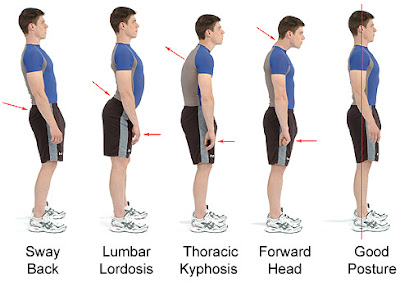 When many people start a new exercise program or join a gym for the first time, it is not uncommon for them to have some sort of postural deviation. Our jobs are often sedentary, where many either sit or stand for long hours, which can eventually cause muscular imbalances and thus pain. People who work jobs involving intense labor often use incorrect movement patterns when moving and placing items, such as bending over to pick up an item instead of bending down. These jobs, coupled with a sedentary lifestyle in general, have created poor posture among the general population that needs to be corrected before a client’s exercise program can focus on his/her main goal.
When many people start a new exercise program or join a gym for the first time, it is not uncommon for them to have some sort of postural deviation. Our jobs are often sedentary, where many either sit or stand for long hours, which can eventually cause muscular imbalances and thus pain. People who work jobs involving intense labor often use incorrect movement patterns when moving and placing items, such as bending over to pick up an item instead of bending down. These jobs, coupled with a sedentary lifestyle in general, have created poor posture among the general population that needs to be corrected before a client’s exercise program can focus on his/her main goal.
The most common postural deviations are sway back, lumbar lordosis, and thoracic kyphosis. Currently I am training someone (for free, of course, since it’s great practice), who suffers from both lumbar lordosis and thoracic kyphosis. However, his lumbar lordosis is improving thanks to my focus on core strengthening and all-over body stretching.
If you want to know if you have any of these postural deviations, simply look in a floor-length mirror, stand naturally, and see if your natural stance has any of the above deviations depicted in the graphic. If you don’t have a floor-length mirror, look in the mirror at the gym or sneak into a dressing room. You can correct your natural stance by manually activating your core muscles, but doing this indicates weakness since they should already be activated in someone with good posture.
If you have lumbar lordosis, your hip flexors and erector spinae are tight. You need to stretch these. You also have weak hamstrings and rectus abdominal muscles, so strengthening of those is vital.
If you have thoracic kyphosis, you need to stretch your anterior chest/shoulders, latissimus dorsi, and neck extensors. You then need to strengthen your upper back extensors, neck flexors, and scapular stabilizers. If you have both, first concentrate on your lumbar region while stretching your thoracic region. Once you’ve corrected your lumbar region, then you can move on to strengthening your thoracic region.
If you have sway-back posture, your hamstrings, lumbar extensors, neck extensors, and upper fibers of your posterior obliques need to be stretched. You then need to strengthen your illiacus/psoas major, rectus femoris, external oblique, upper-back extensors, and neck flexors.
The program I started my friend on to help with his lumbar region involves holding the plank until exhaustion, side bridges until exhaustion, 3 sets of 12 hamstring curls, 3 sets of 12 for any abdominal machine, and 3 sets of 12 for the back extensor machine. I also started him on prisoner rotations while holding a 4-lb. medicine ball. When he moves on to the next phase of his program, I’ll have him start some basic cable exercises and upper body strengthening exercises that cater to the lengthened muscles. I’ll then begin introducing other movements to him that will continue strengthening those core muscles.
When it comes to your lumbar region, endurance is more important than primarily building strength, as this is a true indicator of back health. Thus, endurance involves more reps with fewer rest breaks between sets. You are also going to build strength, but muscular endurance is different in that it is about how long your muscles can sustain a certain activity. For example, I have the strength to lift myself on half-toe while holding on to the barre in ballet class, but I also need endurance to be able to maintain that position throughout an exercise. Without that endurance, I will not be able to do so.
It is imperative to correct postural deviations before focusing on your main goals for your program because if you start any old exercise, you’re going to create more deviations and be at a higher risk of sustaining injuries. For example, you don’t want to start lunges with lumbar lordosis since you have neither the strength nor endurance to stabilize your spine, which is needed for this exercise.
If you have any questions, feel free to either email me at thedancingwriter@gmail.com or leave them in the comments section below!


Great article! And spot on with the postural corrections. Tightness can occur anywhere and paired with imbalances and weakened muscle groups, posture can easily be misshapen. Keep up the awesome articles!
LikeLike
Thanks so much! I’m glad you appreciate this. I think it’s important that more people understand their posture since those who are new to exercise are so likely to get injured if they don’t understand where they need to start.
LikeLiked by 1 person